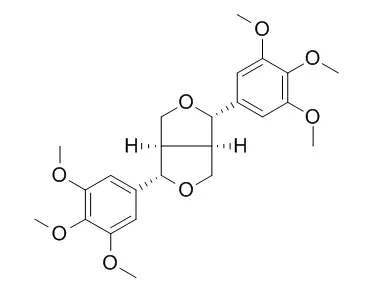| Description: |
Yangambin is a selective antagonist of the cardiovascular effects of platelet activating factor (PAF); it has hypotensive effect, which is probably due to a peripheral vasodilatation that involves, at least, the inhibition the Ca2+ influx through voltage-gated Ca2+ channels.
Yangambin has central nervous system activity, it presents a depressant activity in the open field, forced swimming and pentobarbital sleeping time tests. |
| In vivo: |
| Phytomedicine. 1996 Jan;2(3):235-42. | | Antagonistic effect of yangambin on platelet-activating factor (PAF)-induced cardiovascular collapse.[Pubmed: 23194622] | The cardiovascular protective effects of Yangambin, a novel and specific naturally-occurring platelet activating factor (PAF) receptor antagonist, were investigated in the pentobarbital anesthetized and artificially ventilated rat.
METHODS AND RESULTS:
Yangambin (3-30 mg kg(-1)) as well as the reference PAF antagonist WEB 2086 (0.1-1.0 mg kg(-1)) prevented the circulatory collapse elicited by the intravenous administration of PAF (0.5 μg kg(-1)), in a dose-dependent manner. Yangambin did not interfere with the hypotensive effect of several endogenous vasoactive mediators such as acetylcholine, bradykinin, histamine and serotonin. Moreover, when adminstered as a post-treatment the antagonist showed the ability to reverse the cardiovascular effects induced by PAF (1.0 μg kg(-1)). The protective effect of Yangambin showed to have a duration of action of more than 2 hours.
CONCLUSIONS:
It is concluded that Yangambin is a selective antagonist of the cardiovascular effects of PAF and therefore constitutes a potential therapeutic agent in different shock states where abnormal PAF release is supposed to play an important role. | | Molecules. 2014 May 23;19(5):6863-76. | | Calcium influx inhibition is involved in the hypotensive and vasorelaxant effects induced by yangambin.[Pubmed: 24858272 ] | The pharmacological effects on the cardiovascular system of Yangambin, a lignan isolated from Ocotea duckei Vattimo (Lauraceae), were studied in rats using combined functional and biochemical approaches.
METHODS AND RESULTS:
In non-anaesthetized rats, Yangambin (1, 5, 10, 20, 30 mg/kg, i.v.) induced hypotension (-3.5 ± 0.2; -7.1 ± 0.8; -8.9 ± 1.3; -14 ± 2.3, -25.5% ± 2.6%, respectively) accompanied by tachycardia (5.9 ± 0.5; 5.9 ± 1.6; 8.8 ± 1.4; 11.6, 18.8% ± 3.4%, respectively). In isolated rat atria, Yangambin (0.1 µM-1 mM) had very slight negative inotropic (Emax = 35.6% ± 6.4%) and chronotropic effects (Emax = 10.2% ± 2.9%). In endothelium-intact rat mesenteric artery, Yangambin (0.1 µM-1 mM) induced concentration-dependent relaxation (pD2 = 4.5 ± 0.06) of contractions induced by phenylephrine and this effect was not affected by removal of the endothelium. Interestingly, like nifedipine, the relaxant effect induced by Yangambin was more potent on the contractile response induced by KCl 80 mM (pD2 = 4.8 ± 0.05) when compared to that induced by phenylephrine. Furthermore, Yangambin inhibited CaCl2-induced contractions in a concentration-dependent manner. This lignan also induced relaxation (pD2 = 4.0 ± 0.04) of isolated arteries pre-contracted with S(-)-Bay K 8644. In fura-2/AM-loaded myocytes of rat mesenteric arteries, Yangambin inhibited the Ca2+ signal evoked by KCl 60 mM.
CONCLUSIONS:
In conclusion, these results suggest that the hypotensive effect of Yangambin is probably due to a peripheral vasodilatation that involves, at least, the inhibition the Ca2+ influx through voltage-gated Ca2+ channels. |
|






 Cell. 2018 Jan 11;172(1-2):249-261.e12. doi: 10.1016/j.cell.2017.12.019.IF=36.216(2019)
Cell. 2018 Jan 11;172(1-2):249-261.e12. doi: 10.1016/j.cell.2017.12.019.IF=36.216(2019) Cell Metab. 2020 Mar 3;31(3):534-548.e5. doi: 10.1016/j.cmet.2020.01.002.IF=22.415(2019)
Cell Metab. 2020 Mar 3;31(3):534-548.e5. doi: 10.1016/j.cmet.2020.01.002.IF=22.415(2019) Mol Cell. 2017 Nov 16;68(4):673-685.e6. doi: 10.1016/j.molcel.2017.10.022.IF=14.548(2019)
Mol Cell. 2017 Nov 16;68(4):673-685.e6. doi: 10.1016/j.molcel.2017.10.022.IF=14.548(2019)